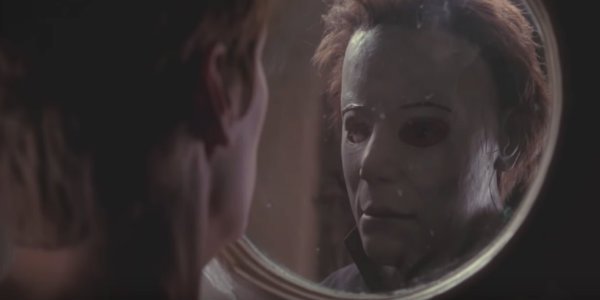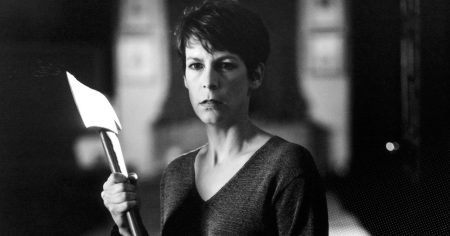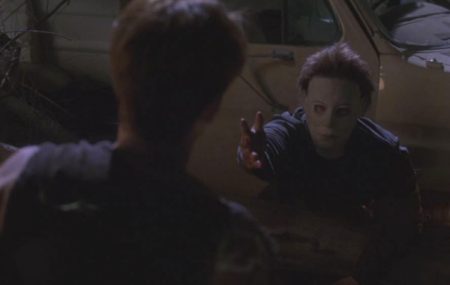Zach’s Sunday Slashers: That other time ‘Halloween’ got a legacy sequel
And it…wasn’t awful?

Laurie Strode (Jamie Lee Curtis) spots Michael Myers (Chris Durand) outside the window of her California home in 1998’s “Halloween: H20 Twenty Years Later”. The film is an early example of a “legacy sequel”, or a follow-up film featuring new characters and plot threads from the original film it is based on. (Courtesy of Miramax)
April 3, 2022
It’s the era of mass-produced, easily marketable movie franchises, and when faced with the choice to make something new, ambitious and original or rehash an old series that is almost guaranteed to sell, well…the decision is pretty simple.
That must have been the thought process at Blumhouse and Universal Studios when they signed off on rebooting the “Halloween” franchise for the third time in 2018. The iconic slasher series had its share of flops and disappointments up to that point, with the last entry, “Halloween: Resurrection” being one of the worst horror films ever made.
It’s no surprise that the series went into hiding for over a decade. There was a remake directed by Rob Zombie in 2007, which reinvented the series, but after its sequel failed to impress at the box office, it was time for yet another attempt. In October of 2018, evil came home once again with a brand new sequel that promised to live up to its namesake and drop all the strange occult lore and overall camp the previous writers had established. The film was generally well-received and remains to me as the best example of a legacy sequel done right.
“Halloween” (2018) serves as a direct continuation of the 1978 original and was followed up with its own sequel, “Halloween Kills” in 2021 and a third entry titled “Halloween Ends” to be released this year. What many may not recall, however, is that this was not the first time the series had been soft-rebooted in much the same way.
After the franchise reached an all-time low with the disaster that was 1995’s “The Curse of Michael Myers”, which featured an almost zombie-like Paul Rudd in his first ever Hollywood gig, it was clear the series needed a serious face lift. In came “Friday the 13th” part 2 and 3 director Steve Miner to helm a brand new “Halloween” sequel that would ignore everything except the first two films in the hopes of rebuilding the public’s faith in the franchise.

The film that finally came out of all of this turmoil was “Halloween: H20 Twenty Years Later” which was released in theaters in 1998. It is, to my knowledge, the first instance of a slasher franchise attempting a return to form by disregarding its own continuity entirely.
Even more interesting is that compared to the series’ previous efforts at continuing the story, this one managed not to completely suck.
“H20” sees Jamie Lee Curtis reprise her role as Laurie Strode, the sister and previous survivor of infamous killer Michael Myers twenty years after the events of “Halloween” I and II. Laurie is depicted as an eccentric and paranoid mother to her teenage son who is often overbearing and protective of him due to her constant fear that Michael will return one day to finish her off.
Sound familiar?
In the opening scenes, a couple teenagers (one of which is played by a young Joseph Gordon-Levitt) explore the former home of infamous killer Michael Myers, only to be killed by Michael alongside the former nurse of the late Dr. Samuel Loomis (formerly played by Donald Pleasence, who passed away before this film was produced).
Aside from the opening, the first half of the film is largely uneventful, mostly focusing on the characterization of Laurie and her son with very few actual kills taking place. Though Michael Myers does appear numerous times, he either does very little to actually harm anyone or is merely an anxious hallucination by the film’s protagonist, Laurie Strode.
Laurie is a lot less manic and desperate in this film compared to the 2018 reboot and though her trauma is clear and present even 20 years later, she deals with it more passively and is seeking to move on.
Though far more emotionally stable than her portrayal in the 2018 film, Laurie is still very paranoid and distraught, often seeing visions of Michael in her daily life as she projects her paranoia onto her son, causing him to grow distant from her.
Overall, Laurie Strode is still mostly consistent as a character, serving as the protective motherly figure to her son, similar to how she is with her daughter and granddaughter in Halloween 2018 and with how she protects the children she babysits in the original film.

“Halloween: H20” and “Halloween” (2018) share some surprising similarities in terms of direction and cinematography as well. Though most of it could be chalked up to homages to the original film, like the panning shot of teenagers walking down the street, and Laurie looking out the window at something or someone that may or may not be there.
There is a scene early on in the film where Michael appears in a public restroom, very similar to one from Halloween 2018, which seemed to be paying homage to it. However, in “H20”, Michael does not actually kill anyone in this scene, instead just stealing a woman’s keys and driving off.
The conservative use of violence and gore in the first half of “H20” does build a surprising amount of suspense at first. It makes the film feel much more grounded than the previous sequels, but it lacks much of the brutality that made the 2018 film so effective.
In “Halloween” (2018), Michael is absolutely brutal, smashing people’s faces in and gutting them with a butcher knife, among other things. In “H20” the violence is toned down in what seems like an attempt at humanizing Michael and telling a much more grounded story, which I can commend screenwriters Robert Zappia and Kevin Williamson for, but it lacks the genuine terror and sense of dread the 2018 film excelled at portraying.
Unlike the 2018 reboot, which retconned every film except the original, “H20” still considered 1981’s “Halloween II” to be canon with the establishment of Laurie as Michael’s sister; something the reboot would do away with entirely. “Halloween II” is an underrated sequel in my opinion, so this addition to the story was something I was more than okay with.
The film ends with a surprisingly touching scene of Laurie grabbing Michael’s hand as he reaches out to her in what seems to be his last bit of humanity seeping through his murderous mind. In contrast to the 2018 film, which has Laurie burning Michael alive in her own house, “Halloween: H20” gives him an almost sympathetic undertone – before she beheads him with an axe.

(Roscoe)
Overall, “Halloween: H20” is not nearly as effective as a horror film compared to the original or the 2018 reboot. It has some interesting character dynamics and a much more unique take on Laurie as a character compared to the twisted and neurotic one we see in the modern trilogy, but it fails to capture the true “essence of evil” that Michael Myers is supposed to represent.
Still, at least they didn’t write one where Michael Myers somehow survives being beheaded and gets into a karate fight with late 1990s rap star Busta Rhymes. That would be awful.



































































































































